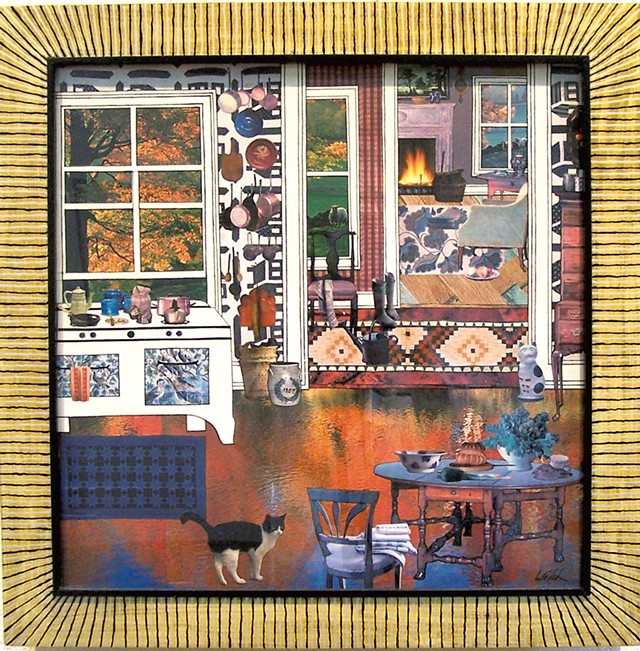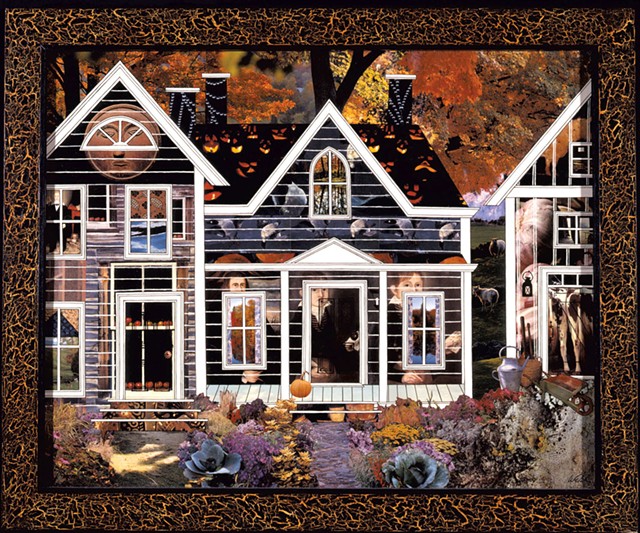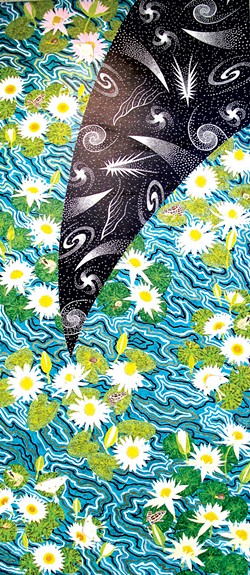
- photos courtesy of the Great Hall
- "October Light"by Mary Welsh
At the Great Hall in Springfield, an exhibition of paintings by Roger Sandes and collages by Mary Welsh, together titled "Signs of Life," celebrates home and the natural world in distinct yet complementary ways. The Williamsville artists, who are married, use color, pattern and familiar imagery in their work. Those elements help the show connect with viewers in the Great Hall's cavernous space.
Sandes' 15 colorful acrylic-on-panel paintings, most from his "Water Garden" series, reverberate with the movement of living things. His images, both horizontal (36 by 78 inches) and vertical (the same dimensions, inverted), may showcase blooming lily pads floating on a pond or a swarm of butterflies aloft on an air current. Trout and red skimmers swim. Frogs sun themselves and dragonflies hover. Harmony abounds.
Welsh and Sandes' perennial garden at home provides inspiration. "Some things thrive, some jump the beds and escape to the fields, some things we love just never last, but the garden endures," Sandes writes in an artist statement. One wonders if his artwork, in turn, affects the garden's design.
Sandes' paintings might be described as belonging to the pattern and decoration school, given to imagery of flora and fauna. They evince the influences of other artists who have used such elements. One might see M.C. Escher's intertwined repetitions in Sandes' horizontal "Butterfly Effect," in which butterflies flutter along a black band that twists and disappears at the edges of the panel. This painting and others make use of swaths of color in a way that recalls Escher's infinite loops.
The gallery labels call these "acrylic paintings," but Sandes more accurately describes them as painted drawings. Up close, pencil lines are clearly visible, showing that the paint was applied after the drawing was completed. The pencil has a purpose, too: Its graphite outlines add sharpness to the flora and fauna, as do bolder black lines from a brush or pen. The works are all on gessoed mahogany or birch plywood panels and finished with a coat of acrylic varnish. The frames, painted by Sandes, are custom made and integral to the work — as are Welsh's.
Sandes invokes Claude Monet's water lilies, though his are far from impressionist. These lily pads and pond are more precise, specific and realistic. Perhaps more important to Sandes' work is the influence of Henri Matisse and his cutouts.
While the size and bright colors of Sandes' paintings make them dominate the room, a visitor can be equally drawn to Welsh's smaller, more intimate collages.
Most of her nine pieces on exhibit are grouped together at one end of the gallery. Shapes and patterns emerge from Welsh's work as the viewer's eye shifts from one unreal image to the next. At a glance, these meticulously cut and crafted works might appear to be a series of home interiors and exteriors. In reality, they are more akin to what our imagination sometimes sees — or misinterprets — in fanciful moments.

- photos courtesy of the Great Hall
- "Jack O'Lantern Farm"by Mary Welsh
"My collages are depictions of what we all take for granted — houses, rooms and their contents," Welsh writes in her artist statement. "Viewing these scenes evokes memories and fantasies."
Welsh and Sandes are members of the Rock River Artists collective of 14 professional artists in southern Vermont. The couple share a 432-square-foot studio housed in a circa-1810 barn that overlooks said river. Its close quarters, with workspaces just a few feet apart, invite "input, helpful hints and lots of support," according to a press release from the gallery.
"I couldn't imagine working alone," Welsh is quoted as saying in the same press release. To which Sandes adds, "We really are a team."
The sense of place and history surrounding the artists' studio figures in their work, especially in some of the vintage images Welsh incorporates. She sources materials from art magazines, art books, calendars and end papers, then affixes the images to prepared birch or mahogany plywood panels.

- photos courtesy of the Great Hall
- "Night of Shooting Stars" by Roger Sandes
"October Light" (26 inches square, frame included) depicts the interior of an old-fashioned country kitchen, with copper-bottomed pots hanging on the wall and a large cast-iron stove. Seen through a window, the outside world is bathed in warm, orange hues: October's light on the fall foliage. That light seems to spill inside, where the highly polished kitchen floor glows in the hues of autumn leaves. Welsh takes the motif a step further: The floor is actually a pond reflecting that light. Yet a table and chairs, a clay jug, a painted oilcloth rug and a cat poise there as if it were a solid surface. Fanciful? Very, but it works.
Welsh intrigues viewers with these inside-out images. Some, like "October Light," are interiors; others are exteriors offering a slightly voyeuristic glimpse into other people's houses and lives. What goes on in there? What do those people do? Welsh poses such questions by layering images of other lives — perhaps past inhabitants' — to the outsides of these houses.
For instance, in "Jack O'Lantern Farm" (28 by 34 inches, frame included), 19th-century portraits appear on the exterior front walls of a house. Rather than ghosts, these are reflections on the history of the place. Perhaps they are meant as a commentary on how our lives could be richer if we recognized those who have come before us in our homes and villages.
For both Sandes and Welsh, artistic influences, extensive travels and living abroad have informed their visual styles and vocabularies. Now, though, they find their inspiration much closer to home.









Comments
Comments are closed.
From 2014-2020, Seven Days allowed readers to comment on all stories posted on our website. While we've appreciated the suggestions and insights, right now Seven Days is prioritizing our core mission — producing high-quality, responsible local journalism — over moderating online debates between readers.
To criticize, correct or praise our reporting, please send us a letter to the editor or send us a tip. We’ll check it out and report the results.
Online comments may return when we have better tech tools for managing them. Thanks for reading.